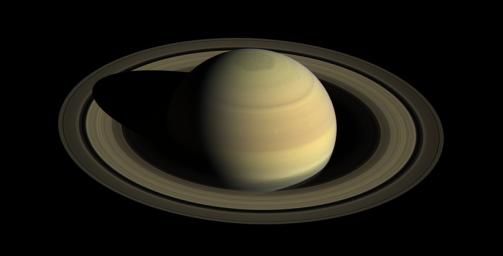Gravity waves from inside Saturn are ringing the planet’s rings
Source: Space.com
Saturn’s rings are ringing like a bell, which is making it possible for researchers to explore deep inside the heart of the planet.
Gravitational forces push seismic waves from Saturn’s interior into its ring system, where NASA’s Cassini mission was able to detect the minute tremors. According to a new study, a large part of the planet’s interior is more layered than previously expected.
Planets hide their interior processes behind hard-to-penetrate layers. While rocky bodies like Earth and the moon can have their layers probed through the study of seismic waves created by quakes, gas giants have no solid surface to measure such waves. Instead, researchers have to employ other methods, such as studying a planet’s magnetic field.
Not long after NASA’s Cassini mission arrived at Saturn in 2004, researchers realized that the planet’s rings were oscillating strangely. Instead of single waves, which are predicted by existing theory, the spacecraft revealed clusters of small waves that could be explained by the presence of gravity waves in the deepest part of the planet’s interior.
“What’s really special about [gravity waves] is that their mere existence requires that at least part of that deep interior to be relatively calm and stable rather than convective,” Christopher Mankovich, a researcher at the California Institute of Technology, told Space.com in an email.
Before these new research emerged, basic understanding of our solar system’s giant planets suggested that their hot fluid interiors pushed heat outward, much like a lava lamp. But the presence of heavy ingredients like rock and water ice beneath the lighter hydrogen and helium can inhibit the movement of the fluid and generate gravity waves. In the case of Saturn, those waves can cause the planet to ring like a bell.
“The detection of internal gravity waves in Saturn through ring seismology is now one of the scant pieces of hard evidence that a significant fraction of Saturn’s interior is stably stratified rather than convective,” Mankovich said.
Ringing like a bell
On rocky planets like Earth, disturbances beneath the planet’s surface can move as a wave, traveling through the planet’s interior and through its surface. As a result, major tremors can be felt hundreds of miles from the epicenter of a strong earthquake. Eventually, interference from other traveling waves can create a standing wave pattern spanning the entire planet.
“This translates into the whole planet ringing like a bell,” Mankovich said.
Like a bell, the characteristics of this wave are dictated by the planet’s size, shape and composition. They reveal insights into large-scale structures beneath the surface, including those that cannot be otherwise accessed.
The same process occurs on Saturn, where a beautiful ring system made up of tiny bits of rock and ice surround the planet. Most of the time, their orbit is calm and orderly, with occasional collisions. Scientists have known for decades that the ring particles can be affected by the gravitational pull of the planet’s 82 moons.While ring seismology was proposed in the early 1990s, it wasn’t until a spacecraft spent time orbiting the planet that the idea could be put into play.
Cassini revealed that Saturn’s rings were also subjected to the tremors of the planet’s oscillating gravitational field. The spacecraft characterized more than 20 waves in the Saturn’s ring system caused by the heart of the planet. The interactions occur only in special places in the rings, but the results can be “dramatic,” according to Mankovich. The effect is small, with the waves only about a single kilometer from peak to peak, while the rings span nearly 180,000 miles (300,000 km).
“These waves are really only obvious at a very fine scale,” Mankovich said. “Cassini made it possible to study these waves in exquisite detail by making the journey to Saturn to study the system up close and personal.”
Understanding what’s going on deep in Saturn’s heart is very much an ongoing process. According to Mankovich, ring seismology favors a thick stable region that makes up roughly a quarter of the planet’s radius. That’s somewhat at odds with understanding gleaned from the planet’s magnetic field, which favors a narrow, stable region only 5 to 10% of the planet’s interior.
Mankovich says that it’s too soon to say what the results imply about the planet’s interior, but that one possibility is that the process that generates the planet’s magnetic field is even more different from its fellow gas giant Jupiter than previously anticipated.
“It will be a fascinating next few years as the full implications of the multi-instrument Cassini data are worked out,” Mankovich said. But far from being dismayed by the clash, Mankovich appeared excited.
“It’s a testament to the power of a spacecraft mission like Cassini that we have such diverse data that different parts of it seem to say different things—it reflects a gap in our understanding and presents an opportunity for discovery. Scientific synergy at its best,” he added.
Source: Space.com

































Leave a Comment
You must be logged in to post a comment.